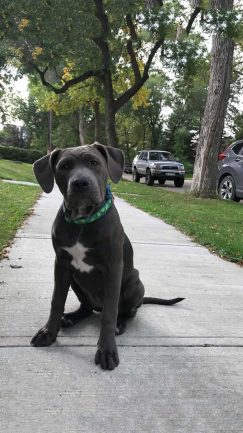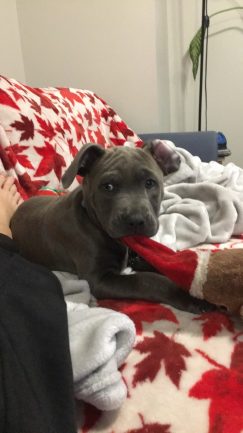A new dog can be a boost of happiness in life, and they’re cuter when they’re just a little puppy. But along with a little puppy comes pee spots on the carpet, chewed shoes and a lot of needed attention. I have trained two puppies that have grown into lovely, well-behaved dogs, including my pitbull Stitch who appears throughout the blog. Here are four steps to training a puppy.
Potty Training

The biggest issue most people have are the messes. As soon as the puppy pees in the house, use harsh words and show them what they’ve done. Hold their head towards it – make sure they can see it and smell it without rubbing their nose in it, and give them a harsh talking to. Then pick them up and take them outside.
If the puppy doesn’t have a way of going in and out by themselves, you can also use the paper method.
If you catch them in the act, take them outside so they can finish there. It’s important to take the puppy outside at regular intervals, even if it has its own way of going outside. That reduces the likelihood of messes inside while reinforcing good behaviour.
While the puppy pees outside, say a cue word like ‘hurry up’. If you say it often while it’s relieving itself, they will begin to associate that word with that feeling. You can also give them treats when they pee outside to reinforce good behaviour. Then, when you are letting the puppy out – and eventually your full grown dog – to pee before bed, you can say that cue and they will pee.
Kennel Training

There will come a day when your dog is good enough to spend their day in the house. Unfortunately, that day is likely not the day you bring them home as a puppy, so they will have to be in a kennel.
It’s easiest to start kennel training them at night, so that they don’t make any messes in their bed. When you buy them a kennel, make sure it is big, with a lot of room to grow, because they will get a lot bigger, and continue to use the kennel. Don’t buy one that is vastly larger than them, it can make them anxious to be in a large space, rather than an enclosed one.
To make your puppy comfortable in the kennel, make sure the puppy has toys, and maybe a bone to chew. One or two toys along with one or two bones is enough, the puppy still needs space to lie down. You can also put a recently worn shirt or sweatshirt in there so the puppy can smell you. This will keep the puppy more at ease, giving it a sense of comfort.
It’s ideal to keep the puppy sleeping in the kennel until it is fully potty trained, same with during the day. Once the puppy is fully trained, you can give it a trial run in the house to see if that works. If not, it will have to go back in the kennel when you aren’t around.
No chewing!

When the puppy comes into your house for the first time, it sees a space full of places to lie and things to play with. You might be okay with the puppy sleeping on everything but will NOT be okay with it chewing on everything.
Have a variety of toys for the puppy. Until you know what it likes, you should have a variety so that your puppy can have options. If your puppy doesn’t have any toys to chew, it will chew on your things.
Make sure your house is clean. If there’s stuff everywhere like garbage and clothes, the puppy will chew on it, because it’s available.
If your is puppy chewing on something it’s not supposed to, say ‘NO’ and take it away. Give the puppy one of its own toys in its place so that the puppy still has something to chew on. Praise the puppy after you substitute the thing being chewed on. The contrast between you saying NO and then later saying ‘good dog’ will help the puppy learn quicker. If you find something that your puppy has chewed, show the puppy. Make sure they see it and say ‘NO’ again. Then give your puppy something else to chew on, or let it continue what it was doing.
Actions and Tricks

Sitting and lying down are staple things to teach a dog and will make your life easier. Many dog parents also love to teach their dogs to shake and roll over. For most actions, it’s easiest to say the word and then make the dog do the trick, until they start to get it on their own.
Sit
Hold a treat in your hand so that the dog will focus on you. Tell the puppy ‘sit’ then push their bum down to make them sit, then give them the treat. After a couple of tries, the puppy will start doing the action on their own to get the treat.
Lie down
Once the puppy is already sitting, tell them ‘lie down.’ Grab both of their front paws and lift them, then gently lower the dog to the floor. This can be made easier once they get the hang of it by bringing the treat to the floor. If the puppy is already sitting, it will lie down to be able to get the treat in your hand.
Come
Getting a puppy to come is less of an action and more of a reinforced cue word. As you grab a treat, tell your puppy to come and it will run to you. Reward it with the treat. Each time you do that, the word ‘come’ reinforces itself into your puppies’ brain as it comes. Eventually you will be able to get it to come to you without a crinkling treat bag.
Stay
Getting a puppy to stay can be more difficult since it wants to be with you and wants the treat. Make the puppy sit. Hold out a hand in a ‘stop’ sign and say ‘stay.’ Take one step away from the puppy and then say ‘come.’ The puppy will come and give it the treat. Continue this pattern and increase the distance each time. If your puppy doesn’t stay, say ‘no’, and repeat the process.
Puppies are a lot of work, but if you can train them well, they’ll grow into good dogs. They’ll always be around and be such a source of love, that makes all the messes and ruined shoes entirely worth it.

